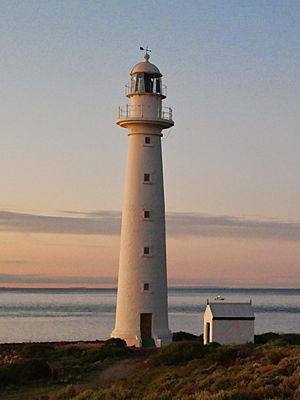Point Lowly Lighthouse facts for kids
 |
|
| Point Lowly Lighthouse | |
|
|
|
| Location | Point Lowly Eyre Peninsula South Australia Australia |
|---|---|
| Coordinates | 32°59′59.1″S 137°47′08.3″E / 32.999750°S 137.785639°E |
| Year first constructed | 1883 |
| Automated | 1973 |
| Deactivated | 1993-1995 2009-2010 |
| Construction | sandstone tower |
| Tower shape | conical tower with double balcony and lantern |
| Markings / pattern | white tower and lantern |
| Height | 22.8 metres (75 ft) |
| Focal height | 23 metres (75 ft) |
| Intensity | 1,000,000 cd |
| Range | 26 nautical miles (48 km; 30 mi) |
| Characteristic | Fl (8) W 40s. |
| Admiralty number | K1948 |
| NGA number | 8524 |
| ARLHS number | AUS-103 |
The Point Lowly lighthouse was built in 1883. Its job was to help ships find their way safely through Spencer Gulf. These ships were often heading to important ports like Port Augusta and Port Pirie in South Australia. The lighthouse was improved many times over the years. It was turned off in 1993 but then turned back on in 1995. Today, it is a popular place for tourists to visit in the Whyalla area and a symbol of Point Lowly.
Contents
What is the History of Point Lowly Lighthouse?
The Point Lowly lighthouse was built in 1883. It helped guide ships through Spencer Gulf to northern ports like Port Augusta and Port Pirie. The lighthouse and its small houses (cottages) were built even before the town of Whyalla existed. This makes them the oldest European buildings in the Whyalla area.
How Was the Lighthouse First Built?
The first tower was 15 metres (about 49 feet) tall. It was made from local sandstone. The light inside had a special lens with eight sides. This lens spun around once every 80 seconds. It created a 2-second flash of light every 10 seconds. Supplies for the lighthouse keepers were brought by boat from Port Pirie.
When Was the Lighthouse Made Taller?
In 1909, the lighthouse was made taller. An extra 7.6 metres (about 25 feet) was added to its height. This made it the height it is today. During this upgrade, the old light, which used mineral oil and a wick, was replaced. A new light that used kerosene vapor was installed instead.
When Did the Lighthouse Become Automated?
In 1973, the lighthouse no longer needed people to operate it. This is called "demanning." A new battery-powered light system was put on the balcony. This system could work on its own.
In 1979, the lens and lamp were improved again. The lighthouse was also connected to the main electricity supply.
What Happened to the Lighthouse in the 1990s?
In 1993, the Australian Maritime Safety Authority decided the light was no longer needed. So, the light was turned off.
However, the community really wanted the lighthouse to be active again. Because of their efforts, the light was turned back on in 1995. Today, the City of Whyalla local government looks after it.
What is the Point Lowly Lighthouse Used for Today?
The Point Lowly Lighthouse is a very well-known landmark in the upper Spencer Gulf area. You can see it in tourism guides and on billboards. It has even been used as a logo by a local group called Save Point Lowly.
Is the Lighthouse a Heritage Site?
Yes, the lighthouse and its surrounding area are protected. A 2.14 hectares (5.3 acres) piece of land, which includes the lighthouse, cottages, and other buildings, is listed as a state heritage place. It has been on the South Australian Heritage Register since December 15, 1994.
The lighthouse is important because of its connection to South Australia's shipping history in the 1880s. Many lighthouses were built then to keep ships safe. The Point Lowly lighthouse also played a part in the growth of Port Pirie, Whyalla, and the mining work done by BHP in the area. The lighthouse was first built from stone in 1883. It was made taller in 1908. The use of concrete in this extension was one of the first times concrete was used in a lighthouse in South Australia.
Can You Stay at the Lighthouse Cottages?
Yes, the cottages next to the lighthouse can be rented out. They can sleep up to 29 people and are managed by the Whyalla City Council. These cottages are often used by people who love diving and by marine scientists. They come to the area each winter to study the cuttlefish that gather there.


